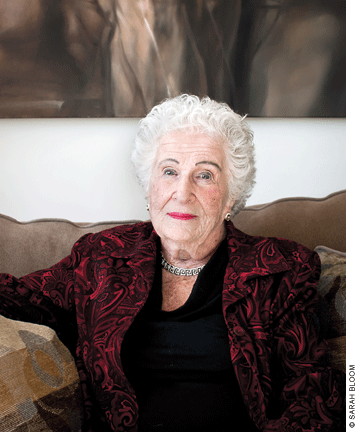
Class of ’35 | Bernice Gordon FA’35, the oldest crossword-puzzle constructor in New York Times history, just wants you to eat something. She’s set out little cream puffs and soft cheese and sesame crackers and a sparkling peach drink, and she hopes her guests will leave pleasantly stuffed. Already stuffed? No problem. She’ll wrap up some extras for you to bring home and eat later.
The last time you encountered Gordon, she may not have been as sweet and breezy and accommodating. You may have gotten angry with her. You may have found yourself chewing on your pen and growling, “I don’t know a six-letter word for powerful canines!”
At 98, Gordon still consistently confounds—and entertains—in her sophisticated crosswords. She sits down at her computer every day, surrounded by weighty reference books, and pieces together a new puzzle. (See “Window” on page 88 for an example.) She’s published more than 150 in the Times, thousands in other newspapers and puzzle books, and currently has about 300 ready to send out. (The backlog came about because she’s outlived many of her puzzle editors, she says.)
She began constructing crosswords in the early 1950s, shortly after her first husband died. They had been married since 1935, the same year Gordon earned her fine-arts degree at Penn.
“My life suddenly became very, very empty,” she says. “When I was by myself one night, I had a thought: I do a crossword puzzle every day. Suppose I try making one. So I tried one and it was easy. I sent it in to [the first Times crossword editor] Margaret Farrar and it came back two days later. My pattern was not right. I used two-letter words. I used words they had never heard of. It was terrible. Try again.”
Undeterred, she created another puzzle and sent it off to Farrar. The reply came quickly: Too many abbreviations. Try again.
“I must have sent in six or seven before one was accepted,” Gordon says. “My first puzzle was published in November of 1952 and I was so hysterical. I went to the drugstore and I bought every copy of The New York Times they had. After that, I got into the swing of making puzzles, and some of them are very good.”
She ranks her first ampersand puzzle, published in the 1960s, at the top of that list. It included 10 solutions in which an ampersand replaced “and,” turning Scandinavia into SC&INAVIA and Carmen Miranda into Carmen MIR&A. Farrar initially rejected the puzzle, calling it “trickery.” Six months later, she told Gordon she’d decided to publish it on a Sunday and see what happened.
“She got letters from people all over the country,” Gordon says. “Some people said, ‘Fabulous, wonderful, loved it.’ The other half said, ‘Disgraceful, it’s tricky, it’s not a real puzzle.’”
Not one to shy away from trickery, Gordon had become the first puzzle-maker to include symbols in her crossword solutions. She went on to create puzzles with asterisks and small drawings in their answers, including a drawn-in car for the solutions JIMMY*TER and BI*BONATE.
She says the key to crossword creation is chronic insomnia. Gordon works from 2 a.m. to 6 a.m. most nights because “that’s when I think best,” and in those late-night-turned-early-morning hours, the ideas just keep coming. Last night, for instance, she thought of using five 15-letter words that begin with lag-, leg-, lig-, log-, and lug-. “You have to have a brain that just goes and goes,” she says.
She also draws inspiration from her travels around the world. Her apartment is full of beautiful souvenirs from her decades of globe-trotting: Spain, Russia, Singapore, China, India, South America. “Name it, I’ve been there,” she says. Her favorite place to visit is Egypt, where she went on her honeymoon at age 20 and returned eight years ago with her son.
“They had never seen a 90-year-old woman go down into the tombs, but I was able to do it,” she says. “If you wanted to take me for a ride, I’d ask you to take me there.”
Gordon will turn 99 in January. On July 2, 2012, halfway through her 98th year, she published her most recent Times puzzle. A writer for the paper’s Wordplay blog summed it up: “Ms. Gordon’s offering today takes a group of French writers and anagrams their names so that the resulting phrase becomes a sort of literary tell-all: Sartre has been arrested, Proust is in his cups, etc. Lesage and Racine fare a bit better on the golf course and at the fair, but I am mainly in awe of someone who can not only anagram well (I can’t do it), but can build a clean and lively puzzle at the age of 98.”
Though she’s been confined to her apartment for the last few years, Gordon has become known in her assisted-living building for her spirit and her crossword expertise.
“They used to cut out very terrible puzzles to give the women who wanted to do them,” she says. She offered to start making crosswords for the group and now, once a week, she sits at the head of a long table helping about a dozen residents solve her puzzles.
“When they raised my rent here, I said, ‘I’m leaving,’ and they said, ‘You can’t. You’re our star attraction,’” Gordon recalls. “I said, ‘Just so you know, the puzzle that I do every week is worth $200, so that’s $800 a month.’ When I told them that, they said, ‘We won’t touch your rent.’”
—Molly Petrilla C’06

